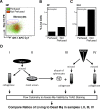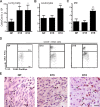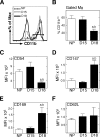Residency and activation of myeloid cells during remodeling of the prepartum murine cervix
- PMID: 22914314
- PMCID: PMC3509777
- DOI: 10.1095/biolreprod.112.101840
Residency and activation of myeloid cells during remodeling of the prepartum murine cervix
Abstract
Remodeling of the cervix is a critical early component of parturition and resembles an inflammatory process. Infiltration and activation of myeloid immune cells along with production of proinflammatory mediators and proteolytic enzymes are hypothesized to regulate cervical remodeling as pregnancy nears term. The present study standardized an approach to assess resident populations of immune cells and phenotypic markers of functional activities related to the mechanism of extracellular matrix degradation in the cervix in preparation for birth. Analysis of cells from the dispersed cervix of mice that were nonpregnant or pregnant (Days 15 and 18 postbreeding) by multicolor flow cytometry indicated increased total cell numbers with pregnancy as well as increased numbers of macrophages, the predominant myeloid cell, by Day 18, the day before birth. The number of activated macrophages involved in matrix metalloproteinase induction (CD147) and signaling for matrix adhesion (CD169) significantly increased by the day before birth. Expression of the adhesion markers CD54 and CD11b by macrophages decreased in the cervix by Day 18 versus that on Day 15 or in nonpregnant mice. The census of cells that expressed the migration marker CD62L was unaffected by pregnancy. The data suggest that remodeling of the cervix at term in mice is associated with recruitment and selective activation of macrophages that promote extracellular matrix degradation. Indices of immigration and activities by macrophages may thus serve as markers for local immune cell activity that is critical for ripening of the cervix in the final common mechanism for parturition at term.
Figures




Comment in
-
The recruitment and activation of leukocytes into the immune cervix: further support that cervical remodeling involves an immune and inflammatory mechanism.Biol Reprod. 2012 Nov 1;87(5):107. doi: 10.1095/biolreprod.112.105049. Print 2012 Nov. Biol Reprod. 2012. PMID: 23018183 No abstract available.
References
-
- Word RA, Li XH, Hnat M, Carrick K. Dynamics of cervical remodeling during pregnancy and parturition: mechanisms and current concepts. Semin Reprod Med 2007; 25: 69 79 - PubMed
-
- Golightly E, Jabbour HN, Norman JE. Endocrine immune interactions in human parturition. Mol Cell Endocrinol 2011; 335: 52 59 - PubMed
-
- Leppert PC. Anatomy and physiology of cervical ripening. Clin Obstet Gynecol 1995; 38: 267 279 - PubMed
-
- Read CP, Word RA, Ruscheinsky MA, Timmons BC, Mahendroo MS. Cervical remodeling during pregnancy and parturition: molecular characterization of the softening phase in mice. Reproduction 2007; 134: 327 340 - PubMed
-
- Hertelendy F, Zakar T. Prostaglandins and the myometrium and cervix. Prostaglandins Leukot Essent Fatty Acids 2004; 70: 207 222 - PubMed
Publication types
MeSH terms
Substances
Grants and funding
LinkOut - more resources
Full Text Sources
Medical
Research Materials

